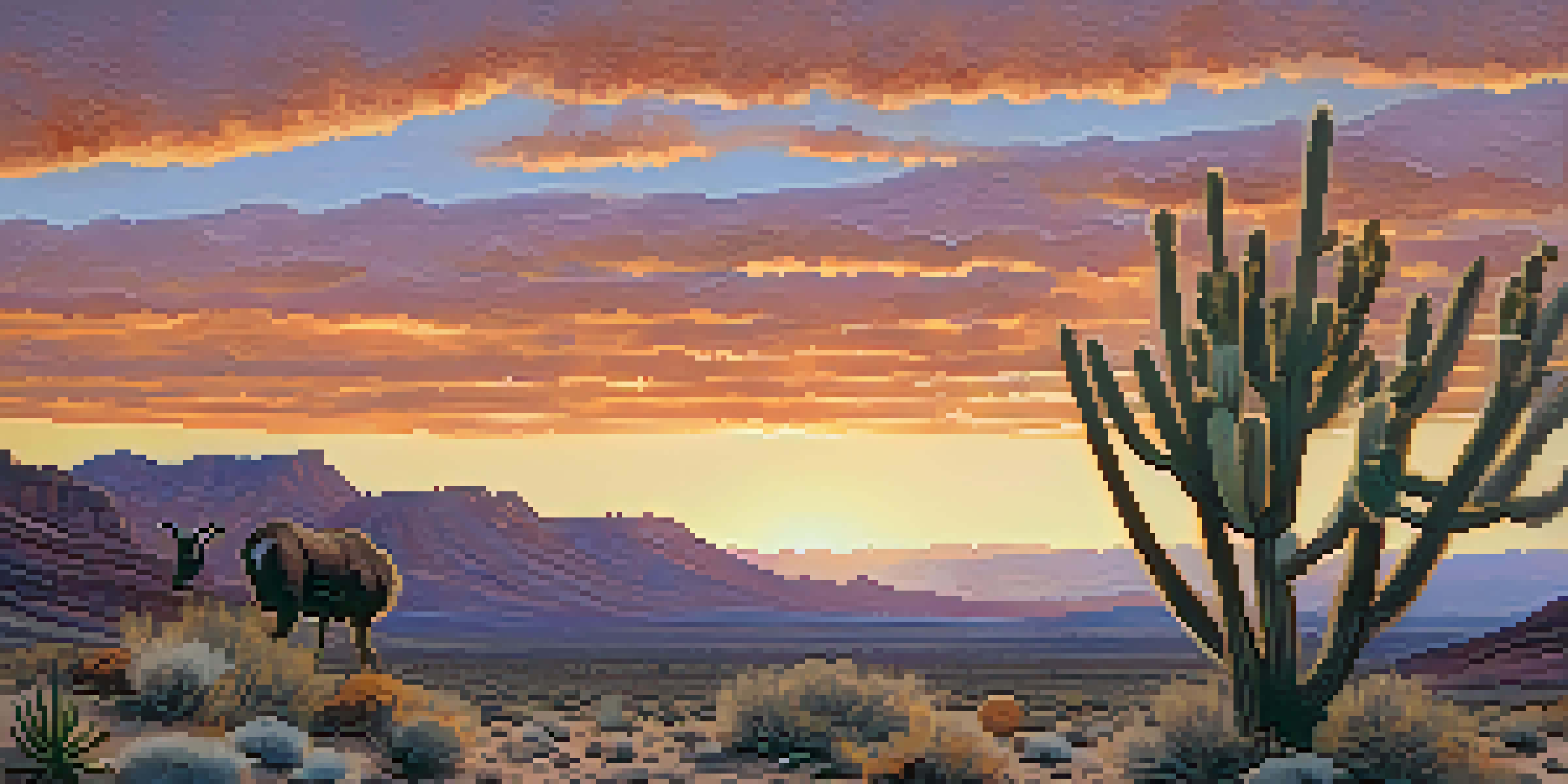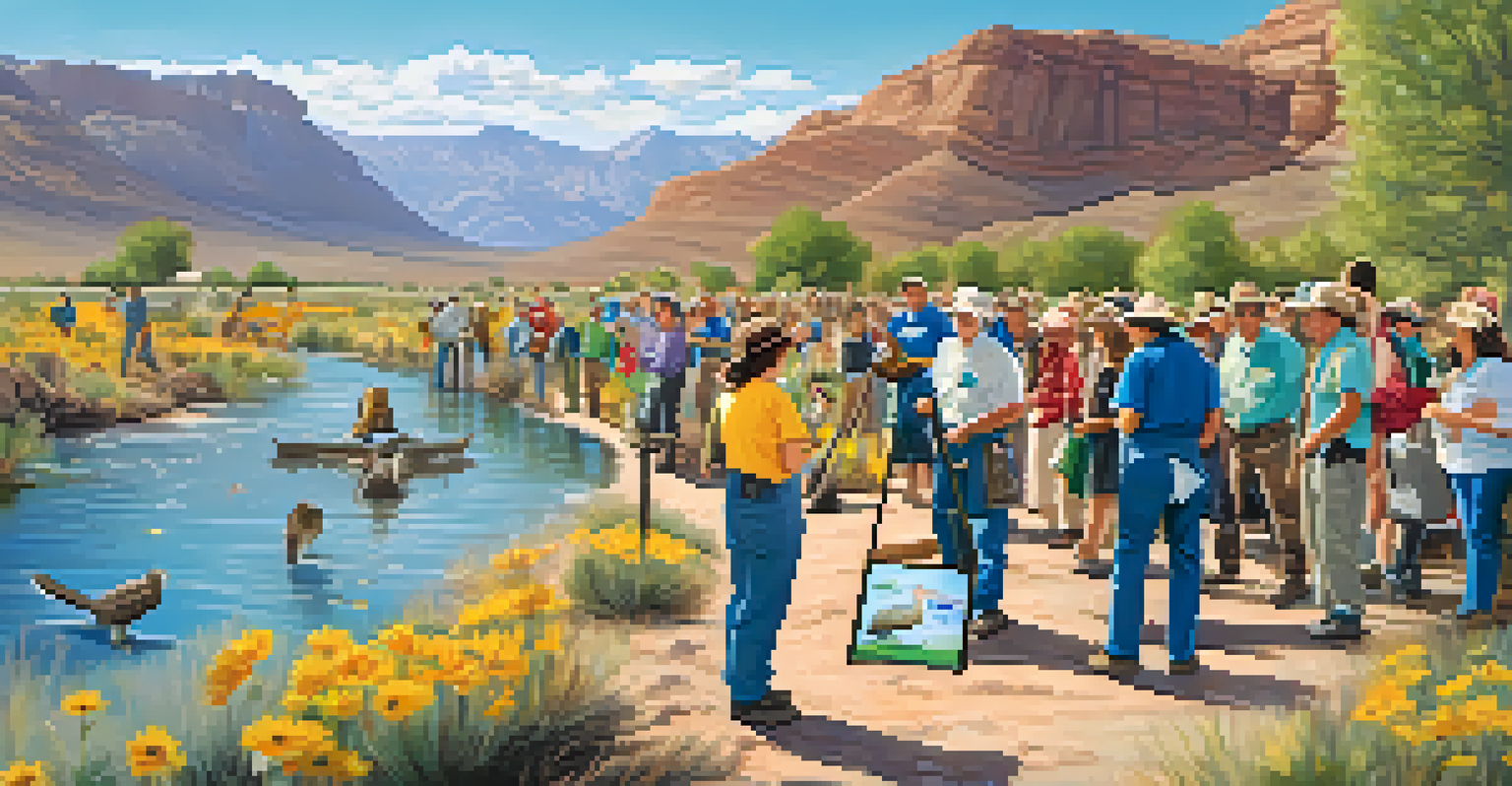Challenges Facing Nevada's Wildlife: A Conservation Perspective

Habitat Loss: The Silent Threat to Nevada's Wildlife
Nevada's wildlife is facing an alarming threat: habitat loss. As urban areas expand and agricultural practices intensify, natural habitats are increasingly fragmented. This not only displaces species but also disrupts the delicate balance of ecosystems. For instance, the expansion of Las Vegas has led to a significant decline in populations of native animals like the desert tortoise.
In nature, nothing exists alone.
The consequences of habitat loss are profound. Animals that once roamed freely are now confined to smaller areas, making it difficult for them to find food, mates, and shelter. This isolation can lead to a decrease in genetic diversity, making populations more vulnerable to disease and environmental changes. Imagine trying to survive in a crowded room where everyone is competing for the same resources—it’s not an ideal situation.
Conservation efforts must prioritize habitat restoration and protection. This includes creating wildlife corridors that connect fragmented habitats, allowing animals to move freely and safely. By safeguarding these essential spaces, we can help maintain the rich biodiversity that makes Nevada unique.
Climate Change: An Overarching Challenge for Wildlife
Climate change poses a significant threat to Nevada's wildlife, altering weather patterns and disrupting ecosystems. Rising temperatures can lead to shifts in food availability, affecting species that rely on specific plants or prey. For example, the warming climate can cause the migration of certain bird species to change, potentially leading to mismatches in breeding times and food supply.

Moreover, extreme weather events, such as droughts and floods, are becoming more common, further stressing wildlife populations. These unpredictable conditions can lead to habitat destruction and increased competition for dwindling resources. Picture a once-thriving oasis now struggling to support the wildlife it once sustained—this is the harsh reality for many species in Nevada.
Habitat Loss Threatens Wildlife
The expansion of urban areas and agriculture in Nevada is fragmenting natural habitats, endangering native wildlife.
Addressing climate change requires a collective effort. By reducing carbon emissions and promoting sustainable practices, we can help mitigate its impact on wildlife. Supporting renewable energy initiatives and advocating for conservation policies are crucial steps in this ongoing battle.
Invasive Species: The Uninvited Guests
Invasive species are a growing concern for Nevada's native wildlife, often outcompeting them for resources. These uninvited guests can alter habitats, disrupt food chains, and introduce diseases that native species are ill-equipped to handle. For instance, the introduction of the cheatgrass plant has transformed many ecosystems, increasing fire risks and outcompeting native plants.
The greatest threat to our planet is the belief that someone else will save it.
The impact of invasive species can be likened to a party crasher who takes over the dance floor, leaving everyone else to watch from the sidelines. Native species struggle to thrive in environments where invasive species dominate, often leading to drastic declines in their populations. This shift not only affects individual species but also the entire ecosystem balance.
To combat this challenge, awareness and education are vital. Promoting the importance of native species and supporting control measures for invasive populations can help preserve Nevada's rich biodiversity. Engaging local communities in conservation efforts can create a stronger defense against these threats.
Water Scarcity: A Growing Concern for Wildlife
Water scarcity is an urgent issue in Nevada, impacting both wildlife and their habitats. With limited water sources, animals like the bighorn sheep rely heavily on specific water locations that are becoming scarcer due to climate change and human activity. As these sources dwindle, competition for water becomes fierce, stressing vulnerable species.
Imagine living in a desert where every drop of water is contested; that’s the reality for many of Nevada’s wildlife. Reduced water availability can lead to decreased reproductive success and increased mortality rates, threatening the survival of species already on the brink. The ripple effects of water scarcity extend throughout the food chain, impacting predators and prey alike.
Climate Change Impacts Ecosystems
Shifts in weather patterns and extreme events due to climate change are severely affecting food availability and habitat stability for wildlife.
Conservation strategies must include sustainable water management practices. Protecting and restoring wetlands and ensuring adequate water supply for wildlife are essential steps in safeguarding Nevada's unique ecosystems. Collaboration between government agencies and conservation organizations can lead to more effective water management solutions.
Wildlife Management: Balancing Human and Animal Needs
Effective wildlife management is crucial in addressing the challenges facing Nevada's wildlife. It involves balancing human activities with the needs of wildlife populations, ensuring both can coexist harmoniously. This often requires careful planning and regulation of hunting, land use, and habitat protection.
Consider the delicate dance between humans and wildlife, where one misstep can lead to negative consequences for both. Overhunting or habitat destruction can lead to population declines, while unchecked human expansion can encroach on critical wildlife habitats. Striking the right balance is essential for the sustainability of both wildlife and human communities.
Collaborative efforts are key to successful wildlife management. Engaging local communities in conservation initiatives and promoting responsible practices can help bridge the gap between human needs and wildlife protection. By fostering a sense of stewardship, we can work together to ensure a brighter future for Nevada's wildlife.
Pollution: A Hidden Danger to Wildlife Health
Pollution is a hidden danger that poses significant risks to Nevada's wildlife. Chemicals from agricultural runoff, industrial waste, and urban development can contaminate habitats, leading to health issues for animals. For example, heavy metals and pesticides can accumulate in the food chain, affecting not just individual species but entire ecosystems.
Imagine a once-pristine lake now filled with harmful substances, impacting all forms of life that depend on it. Wildlife exposed to pollution may experience reproductive problems, decreased immunity, and even death. This chain reaction can have devastating effects on biodiversity, as vulnerable species struggle to survive in contaminated environments.
Community Involvement is Essential
Engaging local communities in conservation efforts is vital for protecting Nevada's wildlife and their habitats.
Addressing pollution requires strong regulations and community involvement. By advocating for cleaner practices and supporting initiatives that reduce waste, we can protect Nevada's wildlife from these hidden threats. Education and awareness campaigns can empower individuals to make choices that benefit both the environment and wildlife health.
Community Involvement: The Heart of Conservation Efforts
Community involvement is the heartbeat of effective conservation efforts in Nevada. Local residents play a crucial role in protecting wildlife and their habitats, whether through volunteer work, advocacy, or education. Engaging the community fosters a sense of ownership and responsibility, making conservation a shared goal.
Think of conservation as a team sport—everyone has a role to play. By participating in local conservation projects, residents can contribute to preserving the unique wildlife that calls Nevada home. Whether it’s participating in cleanup events or joining educational workshops, every action counts in the fight for wildlife conservation.

Building partnerships between conservation organizations and local communities is essential. These collaborations can lead to innovative solutions and greater awareness of the challenges facing wildlife. Together, we can create a more sustainable future for Nevada's wildlife, ensuring that generations to come can enjoy its natural beauty.